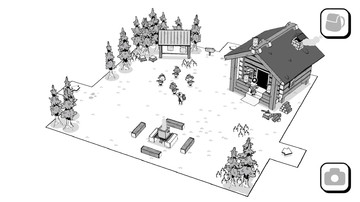
The photos are loved, framed and printed by the inhabitants of the world, so it’s entirely possible to come across a billboard or gallery that is suddenly filled with your best work. We only hit its limit right at the end, as we were hoovering up the last of TOEM’s achievements. Every single photo you take is saved into a reasonably hefty photobook. Quietly, TOEM is a technical marvel, backing all of this up. You’ll be using that camera a lot in TOEM It’s a dense little grotto, and we found ourselves photographing everything, just in case, like true tourists. In each little 3D diorama (TOEM is split into little scenes that are moved between by stepping onto arrows), you can guarantee that there will be at least one creature, one quest, and probably a handful of things to photograph that will contribute to future or past quests. Heading to the top of the blustery mountain in Kiiruberg? You’ll need to wrap up, love. There are photography challenges that act a little like riddles, cosmic blocks hidden in the environment that activate if you photograph them, and various costumes to collect which have their own properties. You can zero-in on achievements, and try to work out what unlocks them. If you’d like, you can take a zoologist route and catalogue all of the beasties that scuttle about the world. The quests are just one way that you can play TOEM. It really is a completionist’s wonderland. And all of the photos and quests are rewarded with a stamp that you get to apply to your passport yourself. Monsters don’t like you being near them, so you have to dink down the tripod and hide behind a wall. You can attach a horn to the camera to honk before taking a photo, getting a startled reaction as you do so. You can apply filters and frames, name the photos, take selfies and plop the camera on a tripod and walk away. TOEM isn’t particularly innovative in the photo-taking, as there’s nothing here that you won’t have done in those other games.

And you can move on or stay for as long as you want. You don’t need to complete all the quests.

It’s made all the better by a complete lack of demand on the player.

Exploring each region, gathering quests and slowly but surely ticking them off until – wahay – you have the threshold to move on is an addictive loop. And it makes for a pressure-free and completely engaging game structure. A bartering system based on good deeds? Yeah, she’d have been all over that. Reach a certain threshold of stamps – you don’t need to gain all of them in an area – and you can hop on the bus and depart. Those stamps are gained by performing ‘good deeds’ for the people around you. To leave your little village of Homelandia, you need a bus ticket, and to get that ticket you need a certain number of stamps on a passport. The world of TOEM works in a curious way that would probably improve things in our world if we adopted it.

Seeing the TOEM is something of a rite of passage, and you will come back with your very own photo, to be placed above the family fireplace. Still, your mother is rather excited for you, so she kits you out with a camera and photobook to put everything in, and then kicks you out the door.


 0 kommentar(er)
0 kommentar(er)
